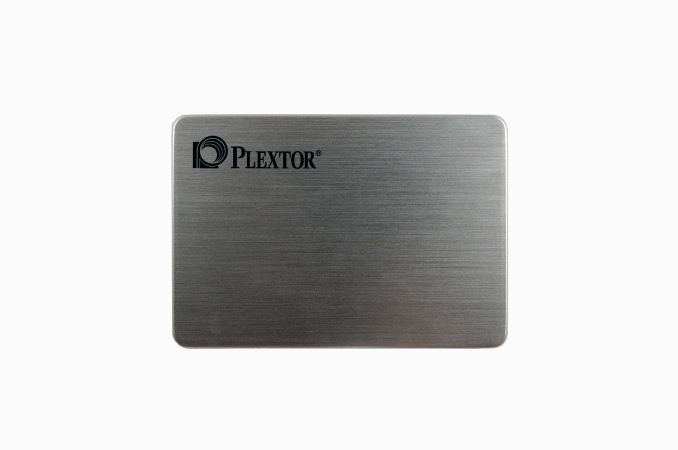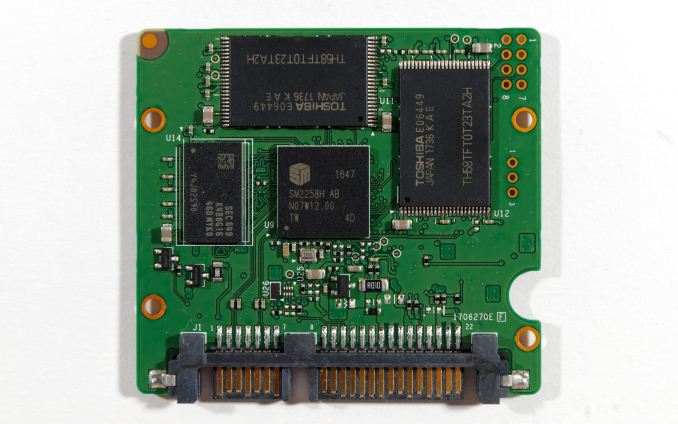The Plextor M8V SATA SSD Review: Toshiba 3D TLC In a Mainstream Drive
by Billy Tallis on March 20, 2018 8:00 AM EST
Today we're taking a look at Plextor's M8V SSD. This is their latest entry-level SATA SSD and the first SATA drive from Plextor to use 64-layer 3D TLC NAND flash memory.
64-layer 3D NAND flash memory started hitting the market last year, but only a handful of consumer SSDs using the latest-generation flash have launched. All of the early models came from the vertically-integrated manufacturers of flash memory and SSDs. Intel, Micron, Toshiba and Western Digital all introduced drives last year with their own 64L 3D TLC. That flash memory is now starting to be used by the rest of the market, as other brands fill in the gaps left by the biggest players.
Plextor is the consumer retail SSD brand of Lite-On, one of the largest SSD manufacturers that is not also a NAND flash manufacturer. One of Lite-On's primary ways of differentiating their SSDs is by developing in-house firmware for the SSD controllers, rather than using the reference firmware provided by most controller vendors. This means that Lite-On/Plextor SSDs often have fairly different performance profiles from drives that at first glance seem to be almost identical technologically.
| Plextor M8V Specifications | ||||
| Capacity | 128 GB | 256 GB | 512 GB | |
| Form Factor | 2.5" SATA and M.2 2280 SATA | |||
| Controller | Silicon Motion SM2258 | |||
| NAND | Toshiba 64-layer 3D TLC | |||
| Sequential Read | up to 560 MB/s | up to 560 MB/s | up to 560 MB/s | |
| Sequential Write | up to 400 MB/s | up to 510 MB/s | up to 520 MB/s | |
| 4KB Random Read | up to 60k IOPS | up to 81k IOPS | up to 82k IOPS | |
| 4KB Random Write | up to 70k IOPS | up to 80k IOPS | up to 81k IOPS | |
| Endurance | 70 TBW | 140 TBW | 280 TBW | |
| Warranty | 3 years | |||
The Plextor M8V is a budget-oriented SATA SSD using Toshiba's 64L 3D TLC. Where Toshiba's own TR200 adopts a DRAMless controller to cut costs, the Plextor M8V uses the mainstream Silicon Motion SM2258 controller. That controller is used in the Crucial MX500, one of the best mainstream SATA SSDs on the market today. A derivative—the SM2259—is used in the Intel 545s. Plextor isn't trying to position the M8V directly against those drives or other top-tier SATA SSDs, but they will still be some of the primary competition for the M8V. The Crucial MX500 will also be one of the more interesting drives to compare the M8V against in terms of performance and power consumption, because the shared controller gives us the opportunity to judge whether Micron or Toshiba's 64L 3D TLC is better.
Our test sample is the 2.5" 512GB M8V. The M.2 version should perform almost identically and use about the same power, and the smaller capacities will definitely be slower—especially the 128GB models. The Plextor M8V features a three-year warranty, but the write endurance ratings are more in line with drives that have five year warranties.
The M8V uses the same brushed aluminum case that Plextor has been using for generations. Inside, we find a small PCB with markings that indicate the M8V is the alter ego of the Lite-On CV8 client SSD for the OEM market. There are two NAND packages on each side of the PCB, and a Samsung DRAM part next to the SM2258 controller. The M8V does not use any thermal pads.
| AnandTech 2017/2018 Consumer SSD Testbed | |
| CPU | Intel Xeon E3 1240 v5 |
| Motherboard | ASRock Fatal1ty E3V5 Performance Gaming/OC |
| Chipset | Intel C232 |
| Memory | 4x 8GB G.SKILL Ripjaws DDR4-2400 CL15 |
| Graphics | AMD Radeon HD 5450, 1920x1200@60Hz |
| Software | Windows 10 x64, version 1709 |
| Linux kernel version 4.14, fio version 3.1 | |
- Thanks to Intel for the Xeon E3 1240 v5 CPU
- Thanks to ASRock for the E3V5 Performance Gaming/OC
- Thanks to G.SKILL for the Ripjaws DDR4-2400 RAM
- Thanks to Corsair for the RM750 power supply, Carbide 200R case, and Hydro H60 CPU cooler
- Thanks to Quarch for the XLC Programmable Power Module and accessories
- Thanks to StarTech for providing a RK2236BKF 22U rack cabinet.
















8 Comments
View All Comments
edgineer - Tuesday, March 20, 2018 - link
What's the actual capacity of this drive, 476 GiB? I hate having to use a calculator/guessing.Billy Tallis - Tuesday, March 20, 2018 - link
As with any other 512GB drive, the usable capacity (before partitioning) is 512,110,190,592 bytes.Dragonstongue - Tuesday, March 20, 2018 - link
Crucial MX200 500GB ends up as 465gb usable Win 7 64 build after formatted for useCrucial MX100 256 ends up with 238GB usable
frenchy_2001 - Tuesday, March 20, 2018 - link
That would be because Windows displays GiB (2^30 bytes) and not GB (10^9 Bytes).https://en.wikipedia.org/wiki/Gibibyte
bug77 - Thursday, March 22, 2018 - link
During formatting, some space is reserved for the file system. That is not a limitation of the drive, nor does it make the drive have a smaller capacity.You don't like file system's overhead? Use a different file system. Oh wait, you can't do that on Windows :D
Holliday75 - Wednesday, March 21, 2018 - link
These new bots are everywhere. Been seeing them all over Facebook posting on a few of my favorite professional sports teams pages.FunBunny2 - Thursday, March 22, 2018 - link
but, but, but... Mark just promised that they've been driving the culture at Facebook for years, years I say, to improve user experience. don't you believe him?????leexgx - Sunday, March 25, 2018 - link
can you please fix on mobile view in "Print this article" the "Thanks to" box overrides page width limits so when scrolling up and down it sometimes go left and right